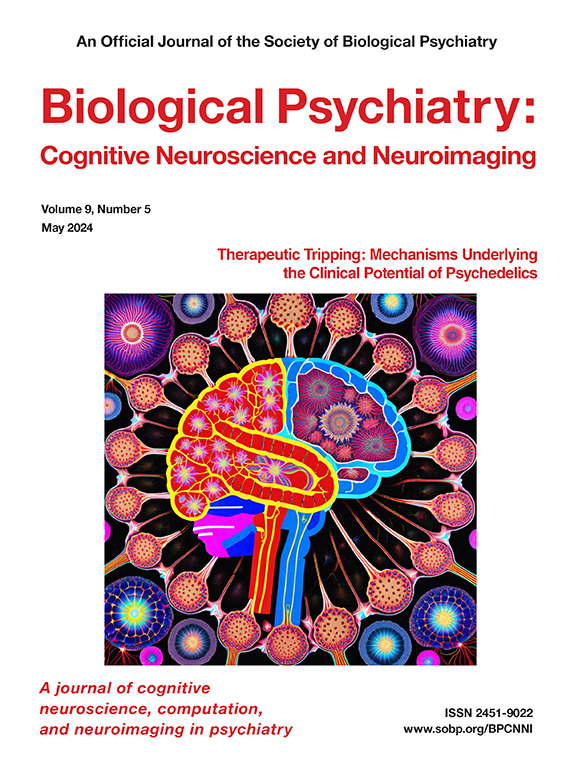Neural Interoceptive Processing Is Modulated by Deep Brain Stimulation to Subcallosal Cingulate Cortex for Treatment-Resistant Depression
IF 4.8
2区 医学
Q1 NEUROSCIENCES
Biological Psychiatry-Cognitive Neuroscience and Neuroimaging
Pub Date : 2025-05-01
DOI:10.1016/j.bpsc.2024.11.021
引用次数: 0
Abstract
Background
Symptoms of depression are associated with impaired interoceptive processing of bodily sensation. The antidepressant effects of subcallosal cingulate deep brain stimulation (SCC DBS) include acute change in bodily sensation, and the SCC target is connected to cortical regions critically involved in interoception. This study tested whether cortical interoceptive processing is modulated by SCC DBS for treatment-resistant depression.
Methods
In 8 patients receiving SCC DBS for treatment-resistant depression, we used electroencephalography to measure the heartbeat-evoked potential (HEP), a putative readout of neural interoception, before surgery and over 6 months of treatment with DBS. We also examined the immediate effect of DBS on the HEP and correlated HEP change over time with outcomes of treatment for depression.
Results
HEP amplitude increased from baseline to 6 months of DBS treatment, and this increase was associated with faster antidepressant response. Recording with stimulation on (vs. off) had an immediate effect on HEP in the laboratory. Overall, modulation of the HEP was most pronounced in sensors over the left parietal cortex.
Conclusions
Brain-based evidence implies an interoceptive element in the mechanism of treatment efficacy with DBS for treatment-resistant depression and substantiates a theorized connection between interoception and depression.
脑深部刺激扣带皮层下胼胝体调节治疗难治性抑郁症的神经内感受加工。
背景:抑郁症的症状与身体感觉的内感受性加工受损有关。胼胝体下扣带深部脑刺激(SCC DBS)的抗抑郁作用包括身体感觉的急性改变,SCC靶点与皮层区域有关,该区域与内感受有关。本研究测试了SCC DBS对治疗难治性抑郁症(TRD)的皮质内感受加工是否有调节作用。方法:在8例接受SCC DBS治疗TRD的患者中,我们使用脑电图(EEG)测量心跳诱发电位(HEP),这是一种假定的神经间感受读数,在手术前和DBS治疗超过6个月。我们还研究了DBS对HEP的直接影响,并将HEP随时间的变化与抑郁症治疗结果相关联。结果:在DBS治疗6个月后,HEP振幅从基线增加,并且这种增加与更快的抗抑郁反应相关。在实验室中,打开(或关闭)刺激记录对HEP有直接影响。总的来说,HEP的调节在左顶叶皮层的传感器中最为明显。结论:基于脑的证据表明,脑深部刺激治疗TRD的疗效机制中存在内感受性因素,并证实了内感受性与抑郁之间的理论联系。
本文章由计算机程序翻译,如有差异,请以英文原文为准。
求助全文
约1分钟内获得全文
求助全文
来源期刊

Biological Psychiatry-Cognitive Neuroscience and Neuroimaging
Neuroscience-Biological Psychiatry
CiteScore
10.40
自引率
1.70%
发文量
247
审稿时长
30 days
期刊介绍:
Biological Psychiatry: Cognitive Neuroscience and Neuroimaging is an official journal of the Society for Biological Psychiatry, whose purpose is to promote excellence in scientific research and education in fields that investigate the nature, causes, mechanisms, and treatments of disorders of thought, emotion, or behavior. In accord with this mission, this peer-reviewed, rapid-publication, international journal focuses on studies using the tools and constructs of cognitive neuroscience, including the full range of non-invasive neuroimaging and human extra- and intracranial physiological recording methodologies. It publishes both basic and clinical studies, including those that incorporate genetic data, pharmacological challenges, and computational modeling approaches. The journal publishes novel results of original research which represent an important new lead or significant impact on the field. Reviews and commentaries that focus on topics of current research and interest are also encouraged.
 求助内容:
求助内容: 应助结果提醒方式:
应助结果提醒方式:


